Why Are Ecommerce Growth Strategies Important?
Growing an ecommerce business is challenging.
Competition is steep. Attention spans are short. And customers are more selective than ever about the brands they purchase from.
Don’t worry.
If you’re wondering how to grow an ecommerce business, this guide is for you. We’ll review eight tactics you can add to your ecommerce growth strategy today.
Let’s get started.
8 Ecommerce Growth Tactics You Can Use
1. Optimize Your Ecommerce Website for Conversion
Optimizing your ecommerce website for conversion can turn more of your visitors into paying customers. That drives revenue and grows your business.
Not optimizing your ecommerce store for conversion is a missed opportunity.
Think about it.
If you drive 100,000 visitors from Instagram to your ecommerce website each month, but your website takes more than 10 seconds to load, many of them—tens of thousands—will just leave.
If your website creates a bad experience for would-be buyers, your marketing efforts are a bit of a waste.
To make sure your website supports your ecommerce strategy effectively, here are tips to optimize for conversion:
Make Your Website Mobile-Friendly
Millions of shoppers use smartphones to make purchases online.
Having a mobile-optimized website isn’t just an option—it’s a necessity.
In addition to being good for your customers, Google has been using mobile-first indexing since 2019. That means, Google prioritizes the mobile version of a webpage for indexing and ranking.
This makes it even more important to optimize your ecommerce website for mobile devices.
Otherwise, it could impact your website’s search engine rankings.
Increase Your Page Speed
Page speed measures how fast webpage content loads.
Load time is crucial—one in four visitors would abandon a website if it takes more than four seconds to load.
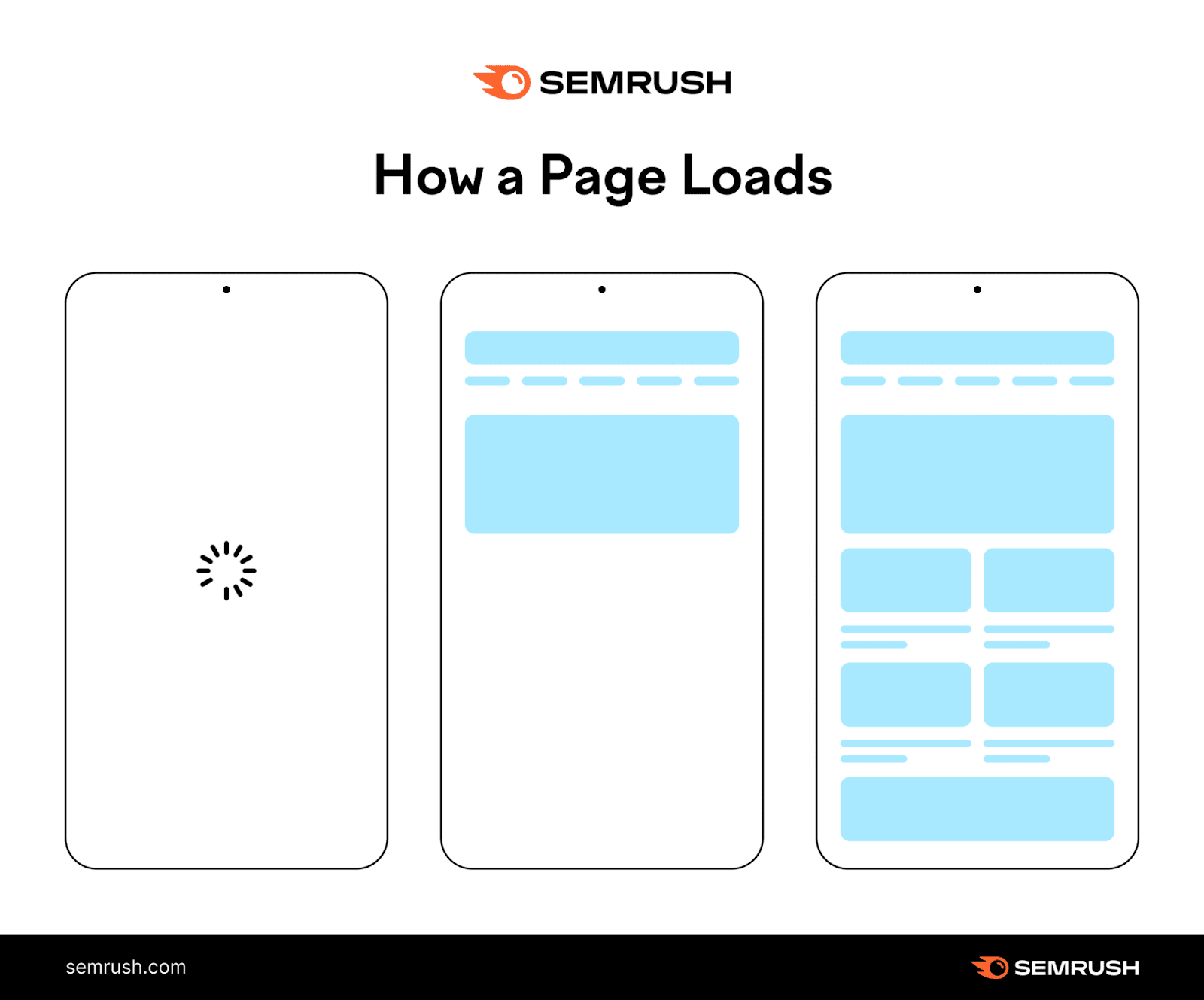
Avoid losing out on potential sales. Make it a priority to increase page speed.
Load time also matters because Google uses page experience as a ranking factor. And page experience includes how quickly your page loads.
Improve Your Website Navigation
Your website navigation can make or break your sales.
Good website navigation helps visitors easily find what they’re looking for, leading to a smoother user experience.
When users can locate what they’re looking for quickly, and without getting frustrated, they are more likely to make a purchase.
An example of good website navigation is Big Chill:
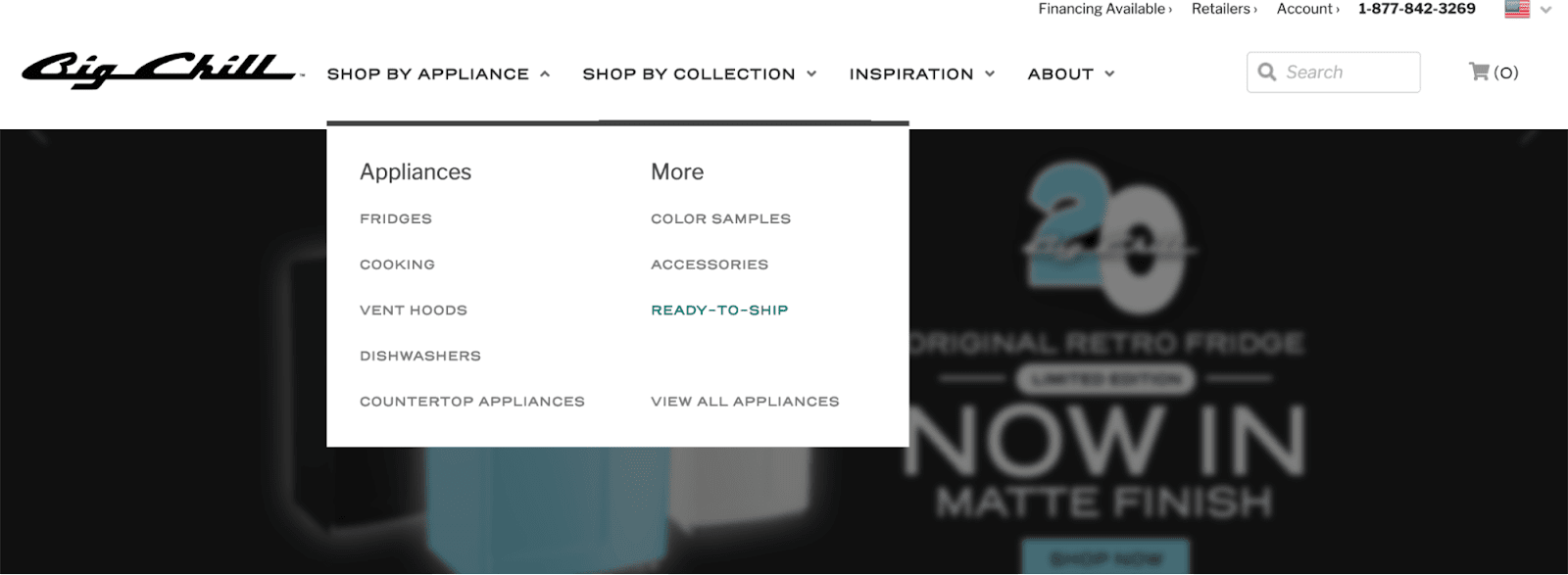
Notice the easily navigable top menu, the directional arrows that mark the user’s current location, the clear naming convention, the obvious search option, and the helpful product categorization.
If your website navigation is too confusing or complex, it can frustrate your customers. And make them leave your website without making a purchase.
Further reading: Check out some great examples of ecommerce navigation for inspiration in 11 Great Examples of Ecommerce Navigation That Can Improve Sales.
Offer Multiple Payment Options
Customers have payment preferences.
Some may like credit cards, while others lean toward digital wallets.

Offering a variety of payment options can help cater to a wider audience and reduce cart abandonment. This is especially true if you sell globally.
Further reading: The 80 Most Common Ecommerce Website Mistakes
2. Optimize Your Store for Search Engines
Search engine optimization (SEO) can help your webpages rank higher in the search results when people search keywords (phrases or queries people type into search engines to find information) that are relevant to your business.
Ranking highly can help attract more traffic to your ecommerce store.
Imagine you have a growing ecommerce business selling leather bags. And one of your premium products is a vintage leather bag. You want to drive traffic to that product page.
Optimizing its product page for the keyword “vintage leather bag” can increase its chances of showing up on search engine results pages (SERPs) when shoppers search for that term.
To get you started, here are a few ecommerce SEO tips:
Perform Keyword Research
Keyword research is the process of finding and analyzing keywords your target audience is likely to enter into search engines. It helps you identify keywords you want to optimize your pages to rank highly for.
Ideally, you’ll want to identify keywords that are:
- Relevant to your brand and products
- Aren’t highly competitive (i.e., low keyword difficulty)
- Have a high number of searches per month (i.e., high search volume)
If you skip this step, your webpages might not rank well in search results for keywords that matter.
For instance, if the keywords you target are too competitive, you might find it challenging to rank on the first page of search results without significant effort, resources, and time.
Or, if you target keywords with very low search volume, your content may rank highly. But it won’t attract much traffic due to the limited number of searches.
An example:
If you sell sports shoes, you may want to rank for keywords like “sports shoes,” “mens sports shoes,” or “womens sports shoes.”
Look these keywords up and you’ll find that they’re very competitive.

Targeting these keywords might not be ideal due to intense competition.
It’s a good idea to find keywords that you have a better chance of ranking for.
How do you find these keywords? The Keyword Magic Tool from Semrush.
To get started, enter a seed keyword. This is a broad search term related to your business or a specific topic. For example, we’ll use “sports shoes.”
Select your country from the drop-down. Then click “Search.”

Next, you’ll see a list of related keywords.
For each keyword, you’ll see its:
- Intent (why people search for it)
- Search volume (how often it’s searched for it each month)
- Keyword difficulty (a score out of 100 showing how hard it is to be in the top 10 organic search results)
Plus other metrics.
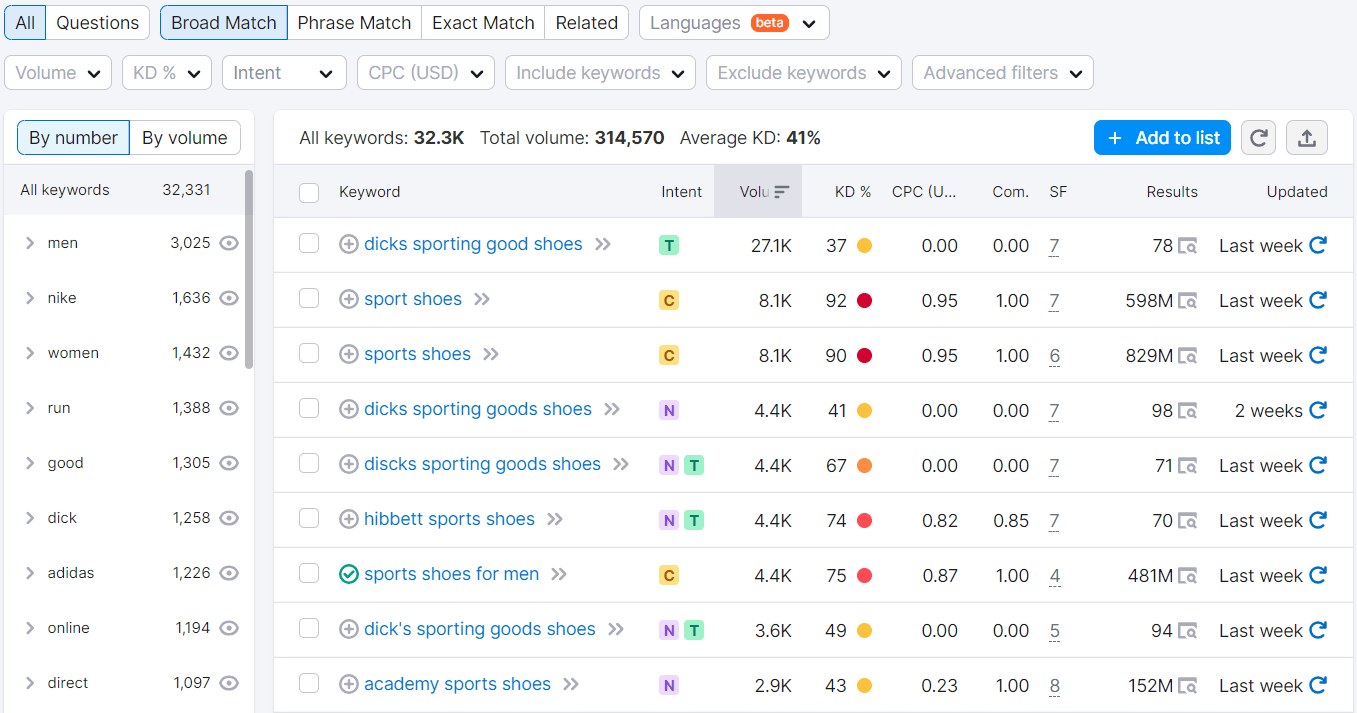
You can find the most popular keywords within your niche through the topical groups and subgroups in the left column of the tool interface.
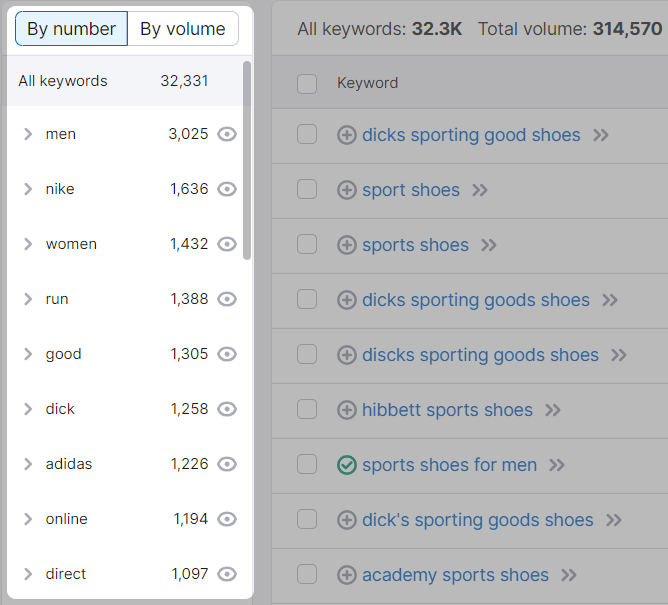
If you specifically want to focus on men’s shoes, you can expand the topical group “men.” Click that keyword in the left column and notice the keywords in the right column adjust.
You can further select from the subgroups to narrow down your search even further.
For example, expand the section under “men” by clicking the arrow next to the term so that it’s pointing down. Now click a subgroup keyword like “run.” Notice the keywords in the right column produce results with both words. Like: “Nike men’s sport trail running shoe.”
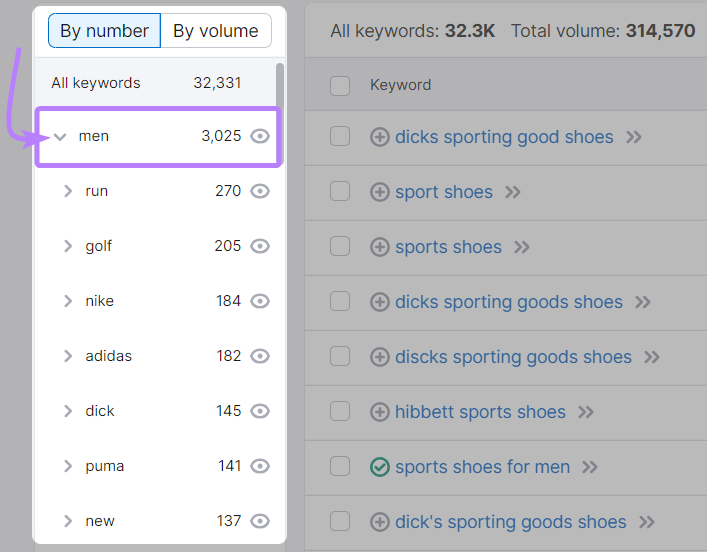
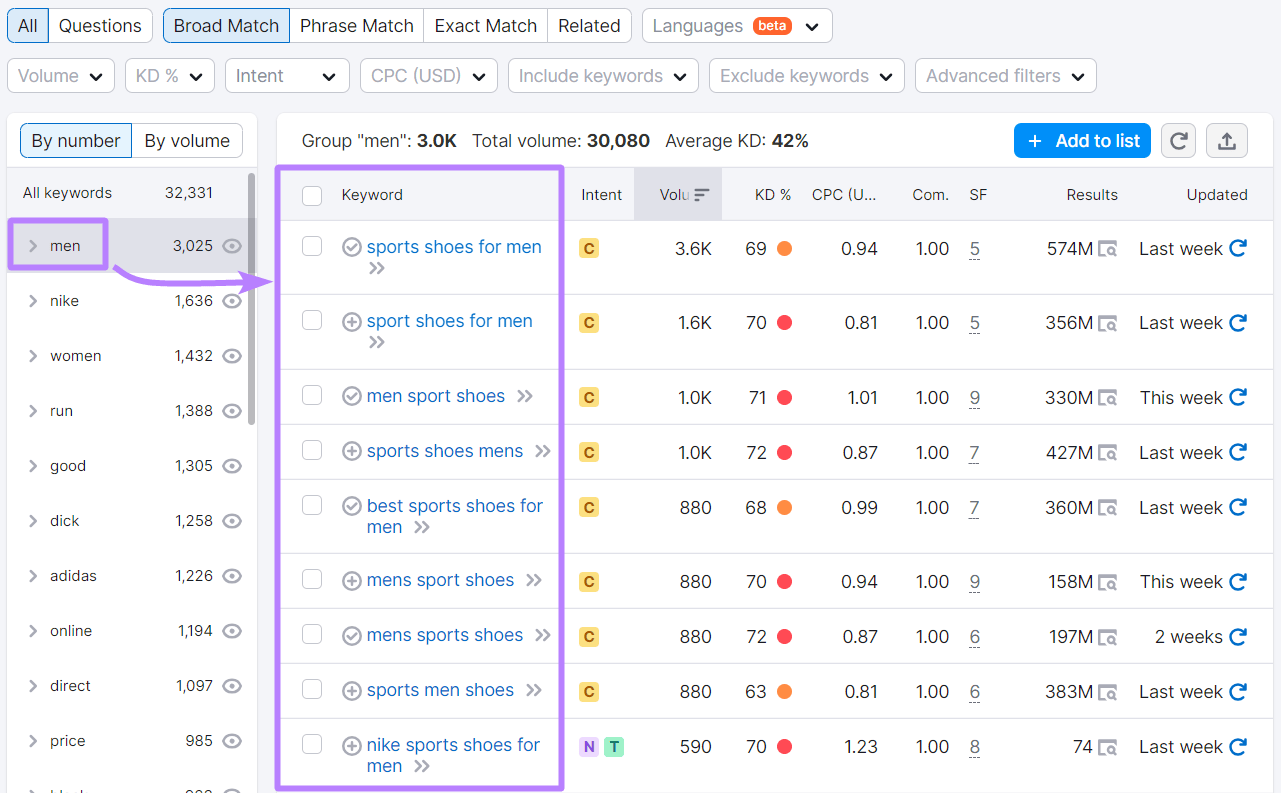
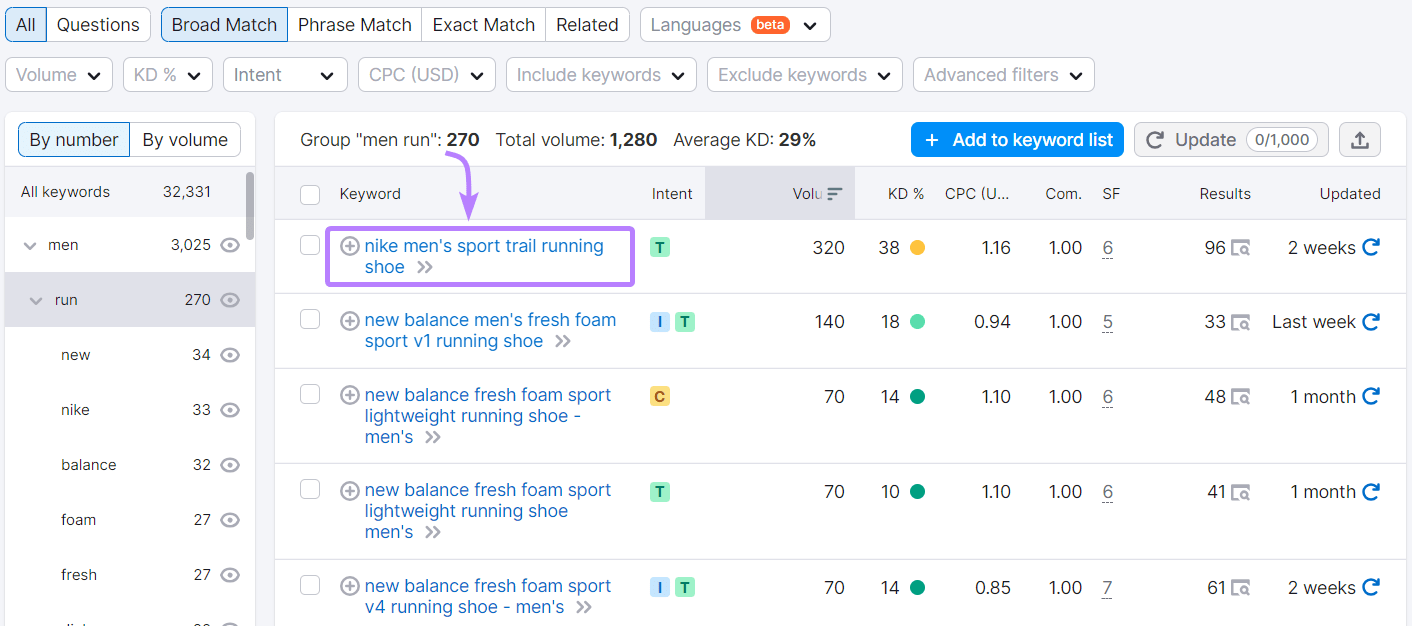
You can also use the Keyword Difficulty drop-down menu to filter results for “Easy” or “Very Easy.” This is a good way to find easy-to-rank-for keywords.
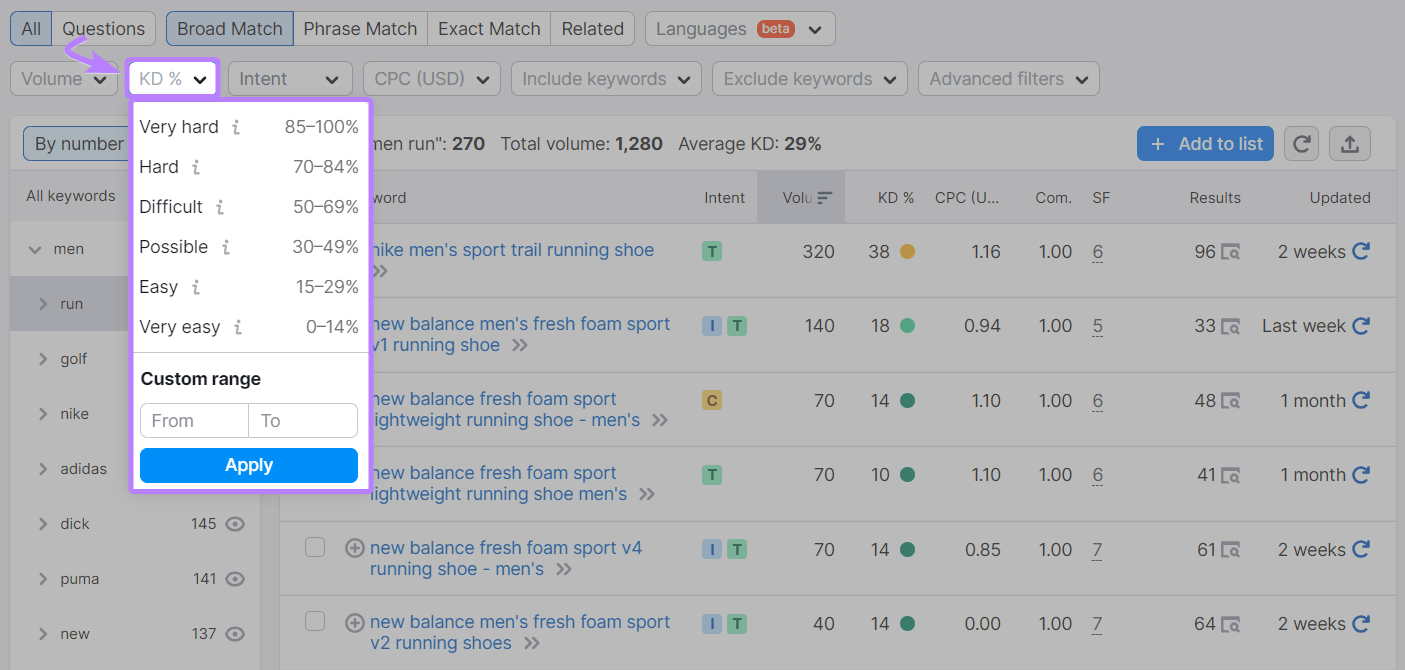
When you find keywords that are relevant, have good search volume, and low enough difficulty, you can add them to a keyword list for easy future reference.
To do that, tick the box next to the keywords you want to add. And click the “+ Add to keyword list” button.
You can either create a new list or add them to an existing one.
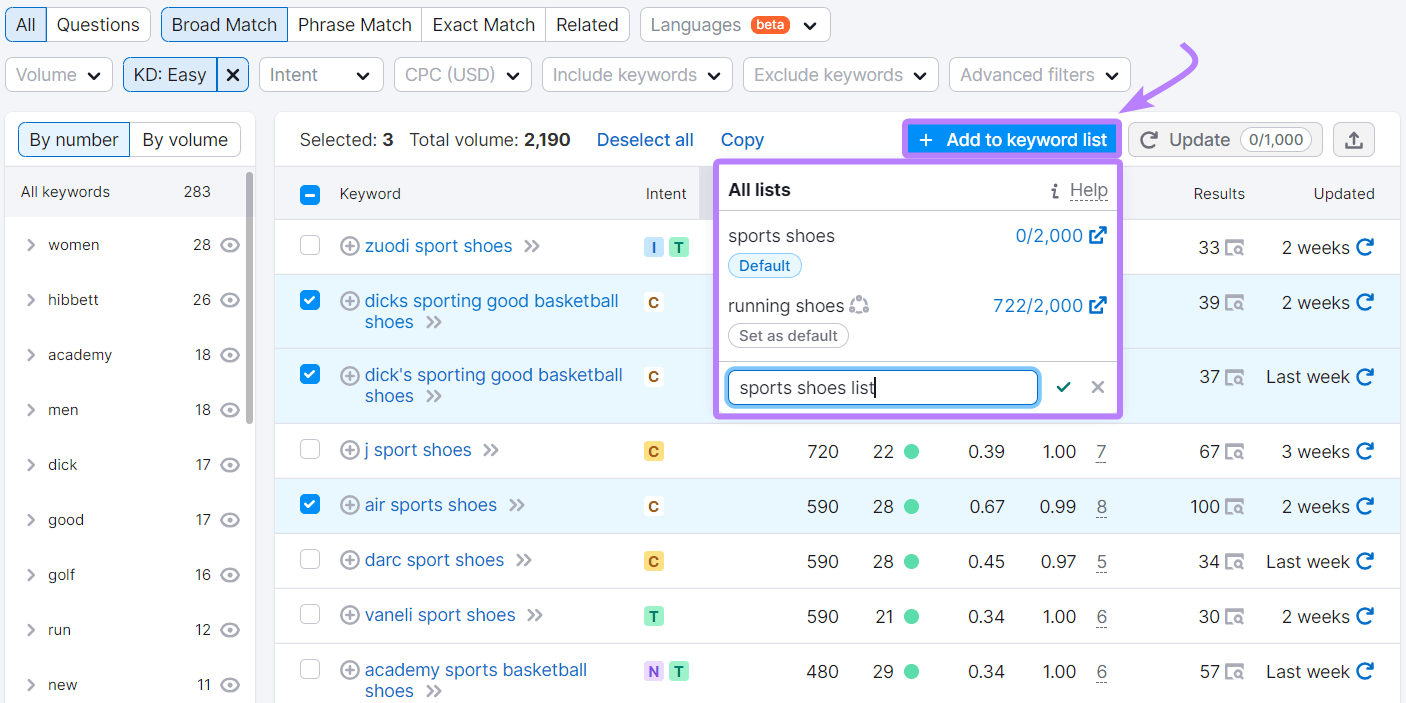
You can export this list in formats like CSV, XLSX, or CSV Semicolon from Keyword Manager.
Optimize Your Website for On-Page SEO
On-page SEO is the process of optimizing the content on your webpages so that they rank higher in search engine results.
This includes creating content that’s unique and helpful, placing keywords strategically, and using headlines and subheads to organize your content well. Optimizing title tags, meta descriptions, alt texts, and other on-page SEO elements helps, too.
Optimizing your website for on-page SEO is important because search engines look at the content to determine whether a page matches the searcher’s intent.
It’s a big part of how search engines determine a webpage’s ranking in search results.
The Site Audit tool helps you identify issues with your on-page SEO.
To get started, click “+ Create project.”
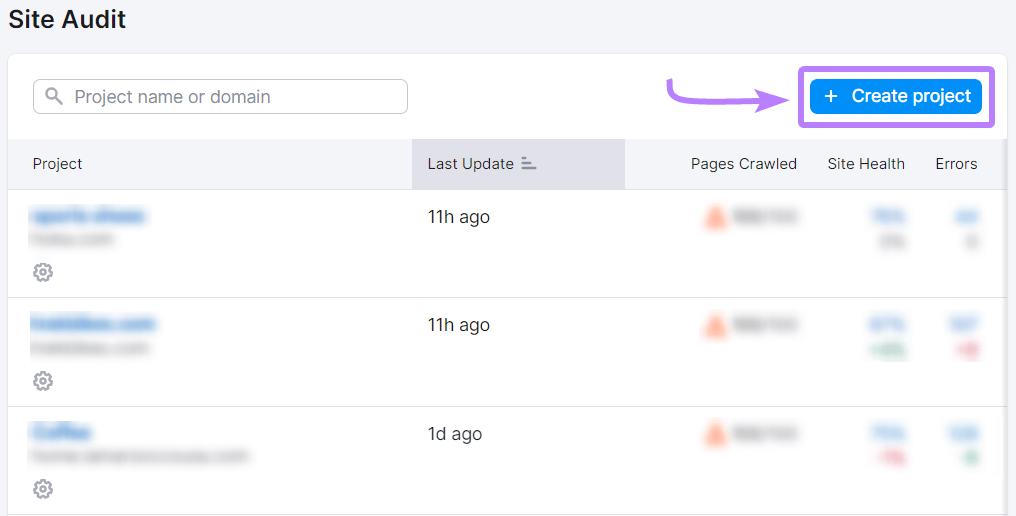
Next, enter your domain and a project name (optional). Then click “Create project.”
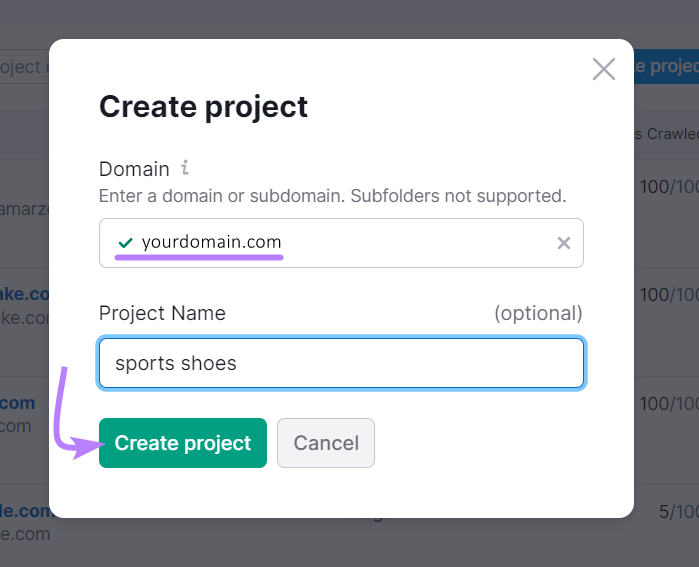
Follow the on-screen instructions to configure your project. If you’re not sure which settings to use, the defaults are a good place to start.
Click “Start Site Audit.”
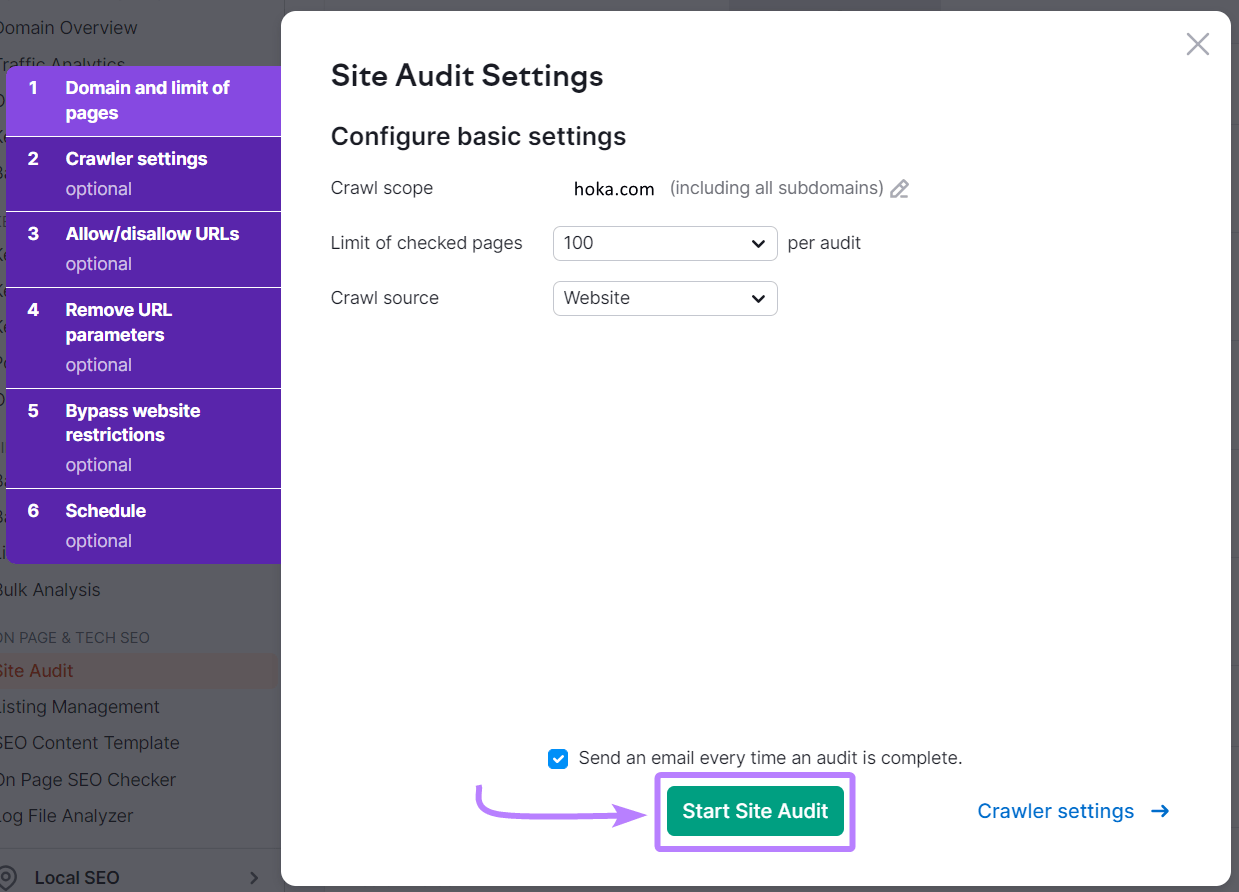
The tool will generate valuable recommendations and insights to optimize your website.
Head over to the “Issues” tab to review addressable errors.
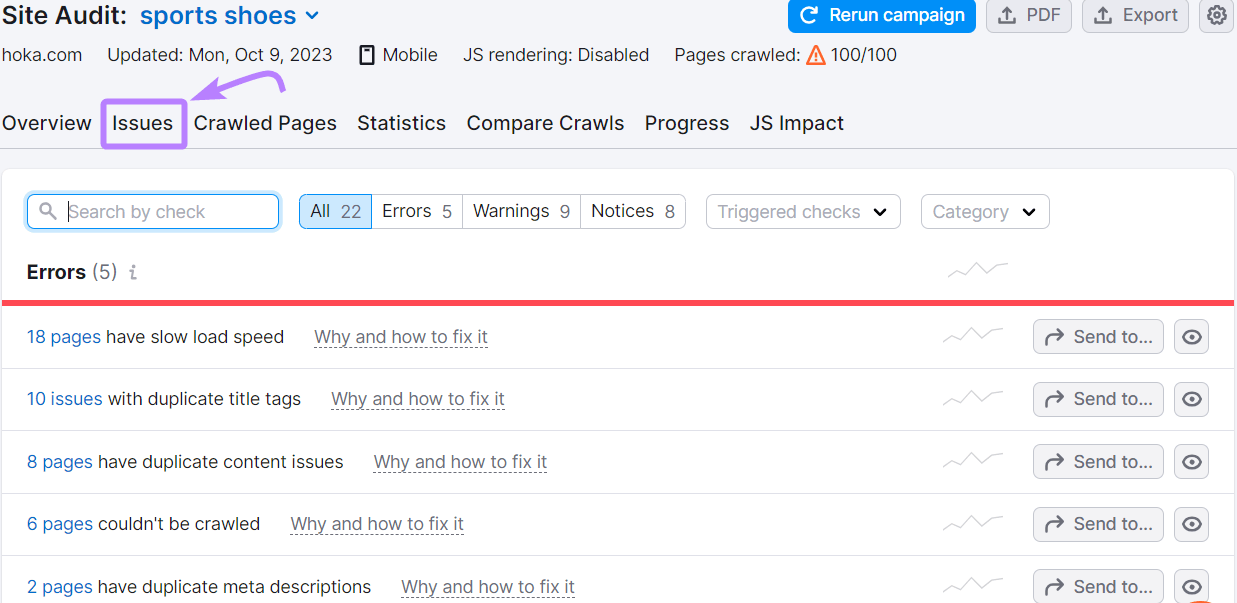

Improve Your Site’s Technical SEO
Technical SEO is the process of optimizing a website so that it’s more accessible, indexable, and crawlable by search engines.
This involves making your website mobile-friendly, improving your website speed, fixing duplicate content issues, and more.
Improving your ecommerce store’s technical SEO can also improve the overall user experience. And since user experience is an important SEO ranking factor, it can indirectly impact your search engine rankings.
Our Site Audit tool can identify technical issues with your ecommerce store.
Follow the steps we performed above to configure your project.
Once you have audit results to review, click the “Overview” tab.
Under “Thematic Reports,” you can review technical SEO aspects of your site like:
- Crawlability: how easily search engines can crawl and index the pages on your website
- HTTPS: how secure your website is
- Site performance: how quickly your site loads
And more.
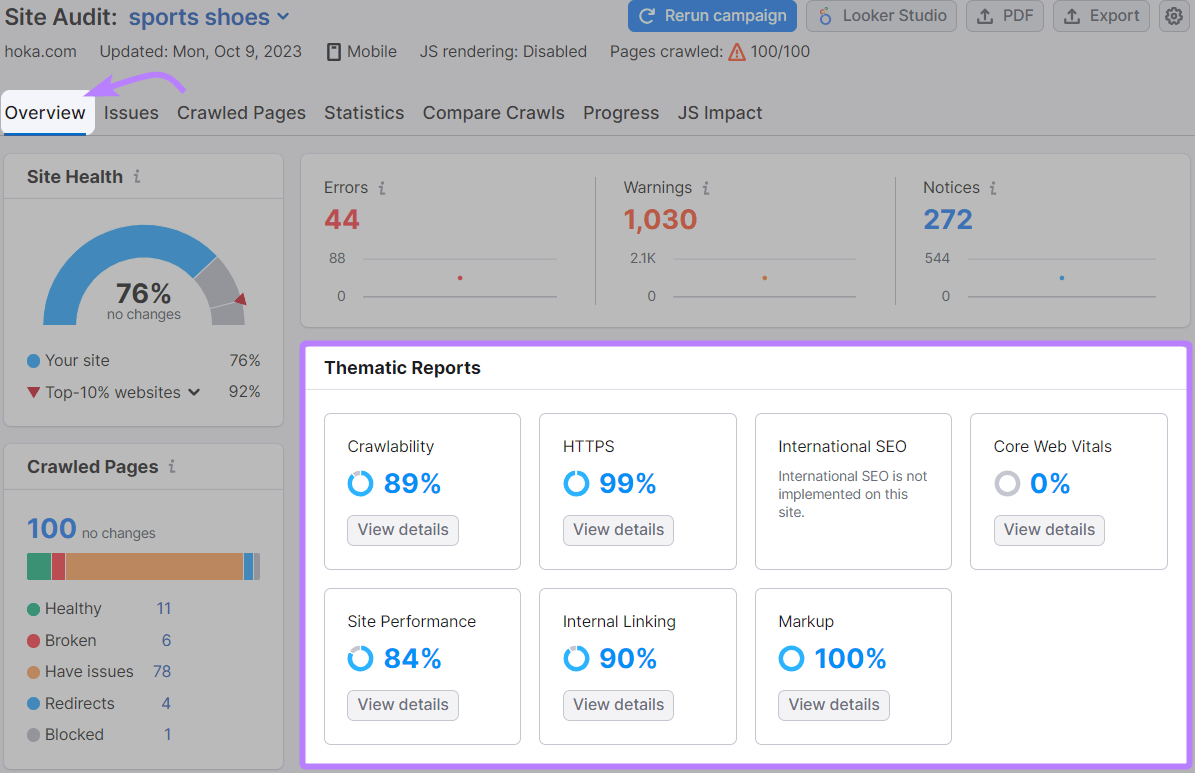
3. Implement a Solid Email Marketing Strategy
Email marketing can help ecommerce businesses drive repeat purchases.
For example, if a customer hasn’t purchased from you in the past 30 days, you can send them an email with a 15% off coupon code to entice them to make another purchase.
Or, if they’ve left items in their shopping cart, you can send them a reminder email along with a convincing offer to encourage them to check out.
Here’s an excellent example of a cart abandonment email by Paro:

Beyond promotions and reminders, you can also use email marketing to empower your customers.
For example:
If you sell kitchen gadgets, you can send them emails with recipes, seasonal cooking inspiration, and kitchen safety tips. In this content, you can highlight how your kitchen gadgets make their overall cooking experience better.
Here’s a great example of an educational email by AllTrails:

Notice how it educates and encourages? This helps them engage with a topic they care about while also building their relationship with you.
To help you implement a solid email marketing strategy, here are a few tips to consider:
Create Segmentable Email Lists
Add data to your email system that will let you send emails to smaller, more targeted lists.
Rather than sending the same emails to everyone, you can send personalized emails to customers based on their specific needs and interests.
For example, if you run a global clothing store, you can segment your email list based on location. If you’ve made sure to collect that data for the customer’s profile.
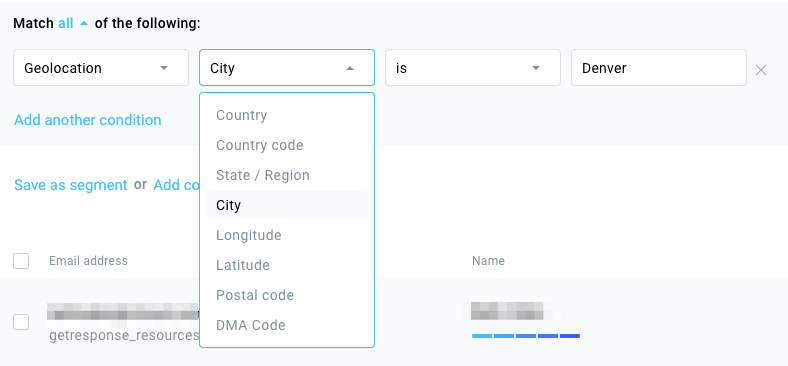
Image Source: GetResponse
Thanks to segmentation, customers in colder regions can get recommendations for winter clothes. And those in warmer areas hear about lightweight fall jackets or layers:

Image Source: Email Tuna
Create Compelling Emails
Your target audience’s inboxes are likely flooded with hundreds of promotional emails that they don’t even plan to open.
So, what would make them open yours?
Compelling email content that makes your customers go “wow.”
Start with crafting catchy subject lines, using high-quality images, including social proof, adding interactive content, and using an attractive template.
Set Up Email Sequences
Set up email sequences to meet customers at the various stages of their buyers’ journeys.
You can set up email sequences like:
- Welcome series: to introduce new customers to your brand
- Educational: to provide valuable content related to your product or industry
- Cart abandonment: to remind customers of products they’ve left behind in their shopping cart
- Post-purchase: to thank customers for their purchase, provide guidance on product use or care, and recommend complementary products that might be of interest
4. Implement a Customer Loyalty Program
Implementing a customer loyalty program can help increase your customer retention rate. It lets you reward your customers for their repeated purchases and engagement.
These rewards can be anything from bonus points to exclusive discounts to free products.
Running a customer loyalty program is a great way to encourage your customers to make even more purchases. As many as 83% of customers have reported that joining a brand’s loyalty program motivates them to purchase from them repeatedly.
It also helps ecommerce brands build strong relationships with their customers. In fact, over 64% of retailers report that they’re able to best connect with their customers through their loyalty programs.
Implementing a customer loyalty program can help you:
- Reduce marketing costs
- Enhance brand loyalty
- Encourage brand and product advocacy
- Deepen relationships with high-value customers
- Receive valuable feedback from loyal customers
Sephora’s customer loyalty program called “Beauty Insider” is an excellent example. They offer a tiered system in which the benefits increase as customers spend more.

Beginning as an “Insider,” customers can graduate to “VIB” and “Rouge” levels by spending $350 and $1000 in a year, respectively.
Each level offers unique benefits.
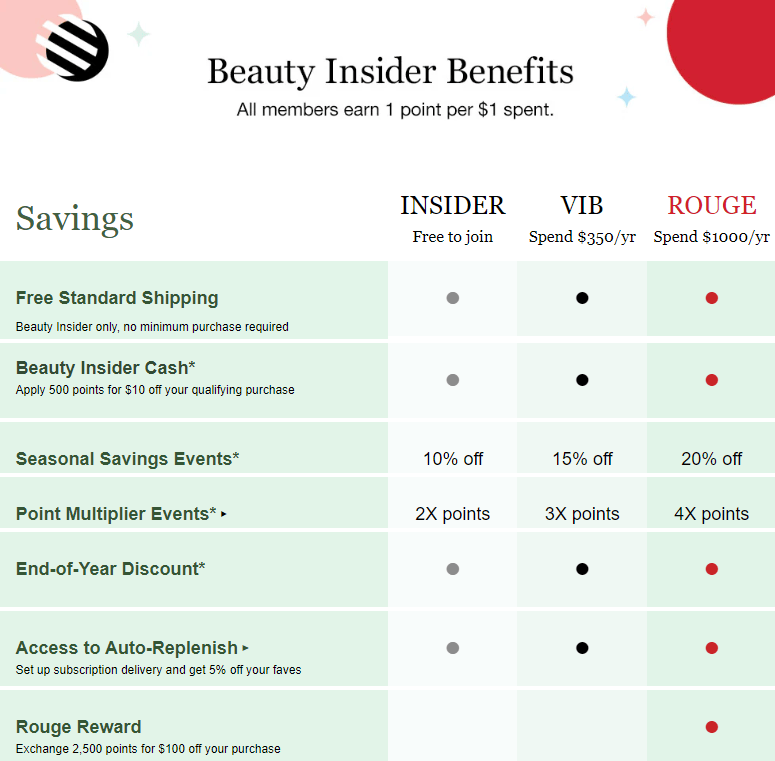
Here are a few tips to consider for a successful customer loyalty program:
- Offer graduated tiers of rewards based on clearly defined levels of customer loyalty
- Communicate the benefits and rewards in simple and easy-to-understand language
- Make it easy for your customers to join your customer loyalty program
- Increase awareness by emailing your customers about your brand’s loyalty program
- Offer additional points or rewards to customers who promote your brand or loyalty program on social media
As many as 82% of shoppers use social media to make a purchase.
Establishing your brand’s social media presence can help you reach more customers, increase brand awareness, and drive sales.
Moreover, interacting with your audience on social media is a great way to build long-lasting relationships with customers. And gain valuable insights about their needs and preferences.
Building your brand’s social media presence can attract new customers. While also retaining existing ones.
An example:
Prior to the COVID-19 pandemic, Milk Bar, a U.S.-based chain of dessert and bakery restaurants, generated 75% of its revenue from their physical stores. The other 25% came from online sales.
When the pandemic hit, they were at risk of losing the majority of their revenue.
To avoid this, Christina Tosi, Founder & CEO at Milk Bar, began establishing the brand’s presence on Instagram.
Fast forward to today, Milk Bar’s Instagram account has more than 800K followers.
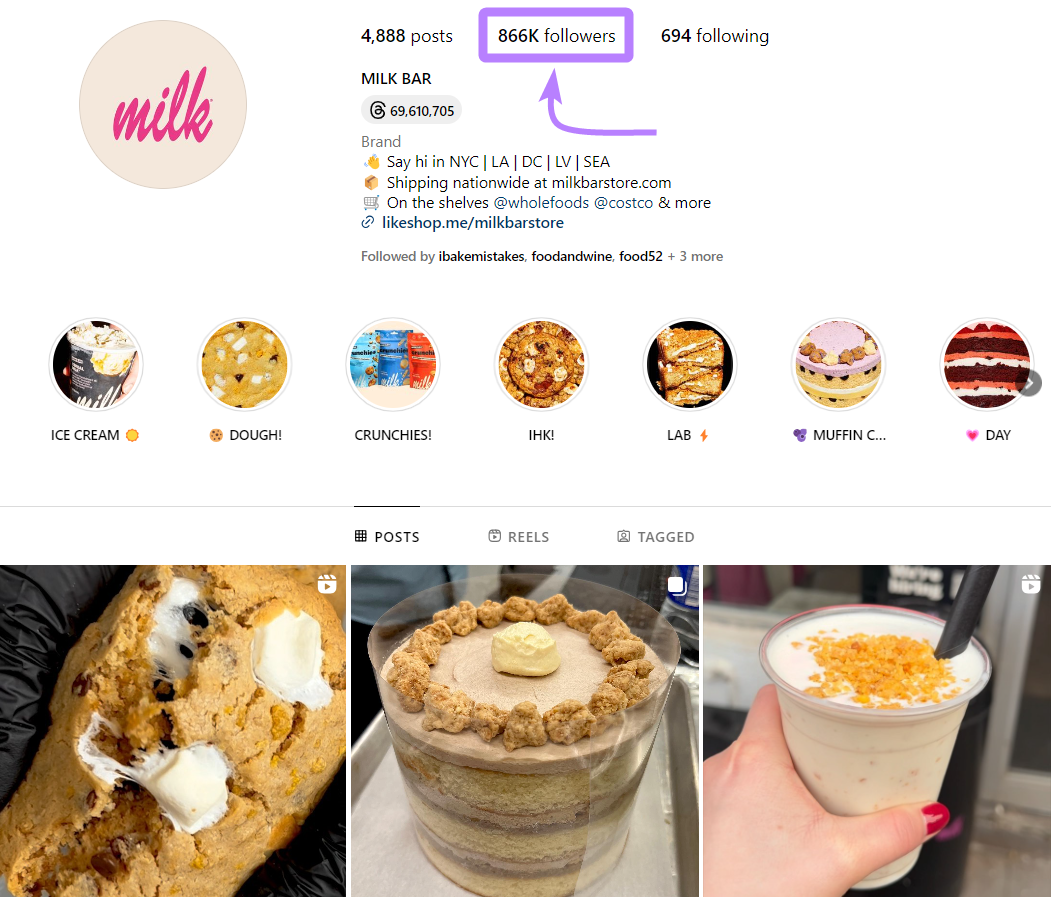
They also have over 100K followers on Facebook, 200K followers on TikTok, and 50K+ followers on X (formerly Twitter).
Their posts and videos garner serious engagement.
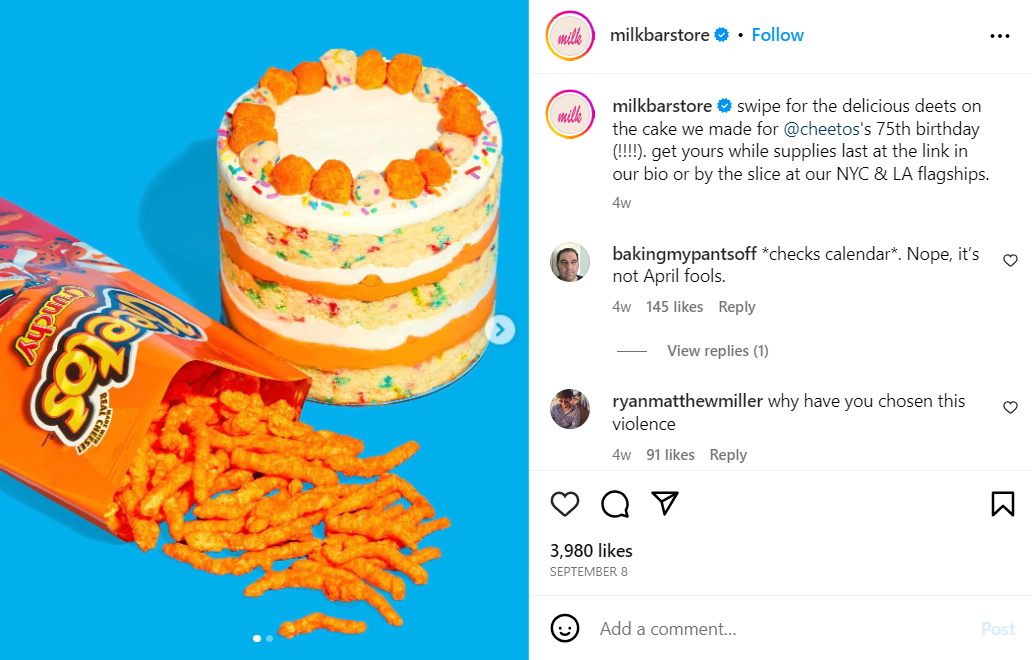
They drive a lot of traffic to their ecommerce store from social media.
Just like Milk Bar, you can integrate social media platforms like Instagram, X, TikTok and others in your ecommerce strategy to grow your ecommerce business.
To help you get started, here are a few social media tips to consider:
Choose the Right Social Media Platforms
Analyze which social media platforms your target audience uses the most.
Plan to establish your presence on those platforms.
For example: if you sell sports shoes and your target audience is millennials, you may want to focus on Instagram, TikTok, and Pinterest.
Volume for that demographic is higher there than it may be on, say, LinkedIn.

Publish Engaging Content
To reach more people and keep your existing followers engaged, creating engaging social media content is essential.

However, producing compelling content regularly can feel like a burden. It can get expensive, too.
To remove some of that burden and keep from overshooting your budget, you can:
- Leverage user-generated content (content created by your customers)
- Share customer testimonials
- Repurpose existing content
Leverage Paid Social Ads
Establishing your social media presence organically takes time.
To reach your target audience faster, it might be a good idea to run paid social media ads.

Leveraging paid social media ads can increase your brand awareness, attract more followers, and drive more people to your ecommerce store faster.
Track Your Social Media Performance Regularly
Make it a habit to look at your stats on social media.
Track social media metrics like impressions, reach, likes, comments, follower/subscriber growth rate, engagement rate, and more.
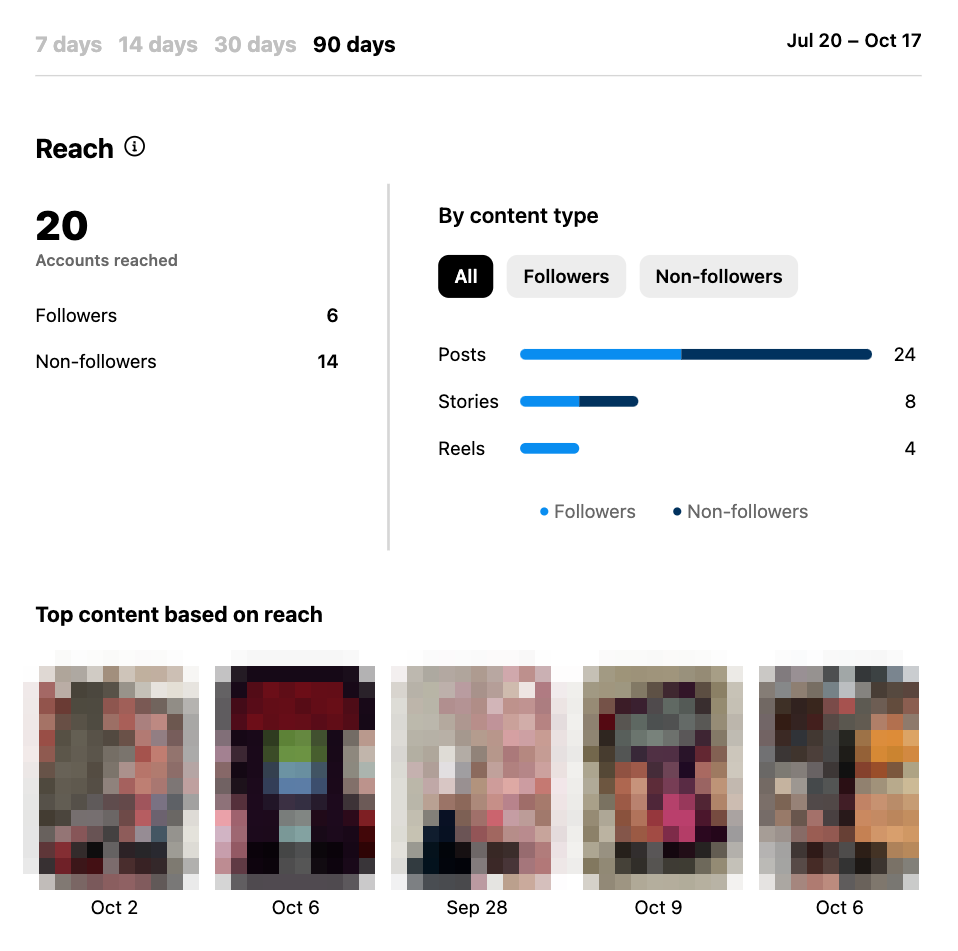
If you’re tracking metrics across multiple platforms, this task can be challenging.
To make things easier, you can use the Social Analytics tool.
This tool lets you track your performance across different social media channels all under one roof.
To get started, open Semrush. Click “Social Media.” Then click “Social Analytics.”
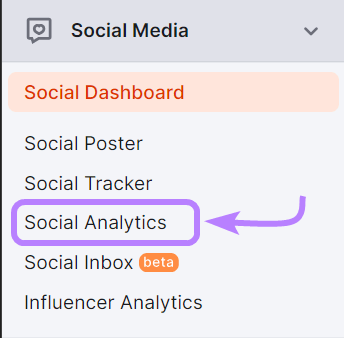
Connect your social media profiles.
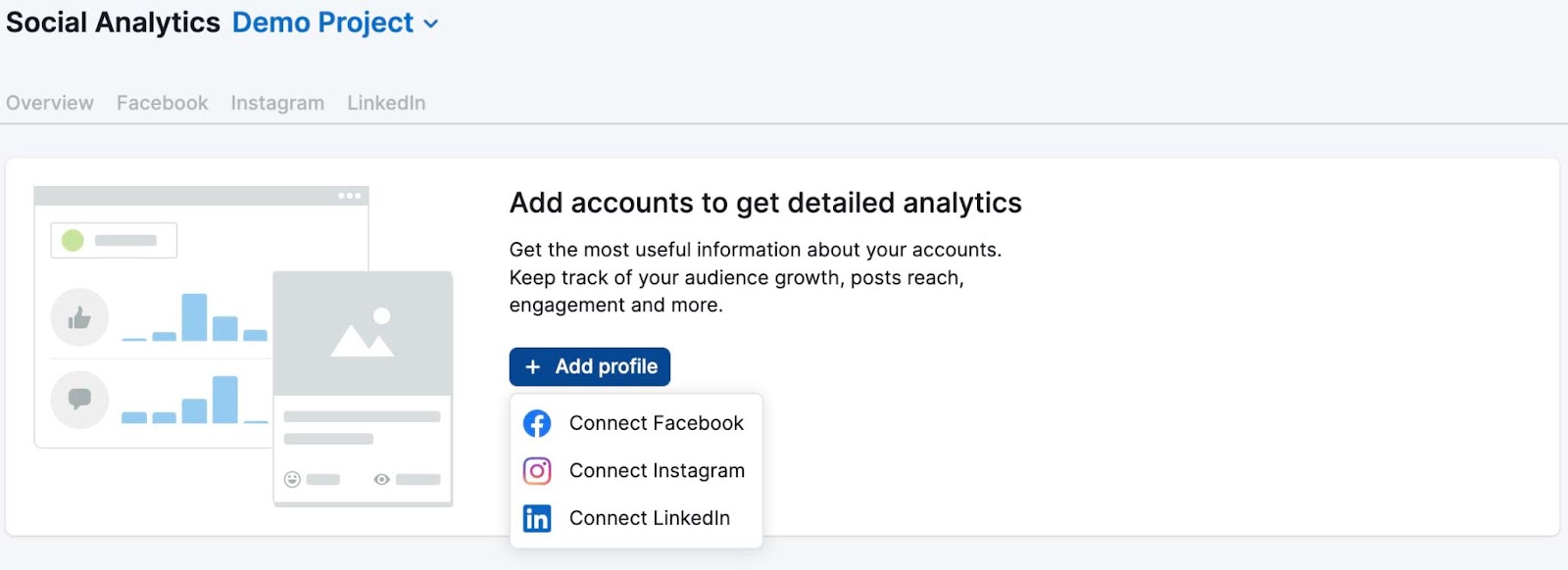
Once connected, you can analyze metrics like a post’s reach and engagement, new followers, and your engagement rate across different platforms.
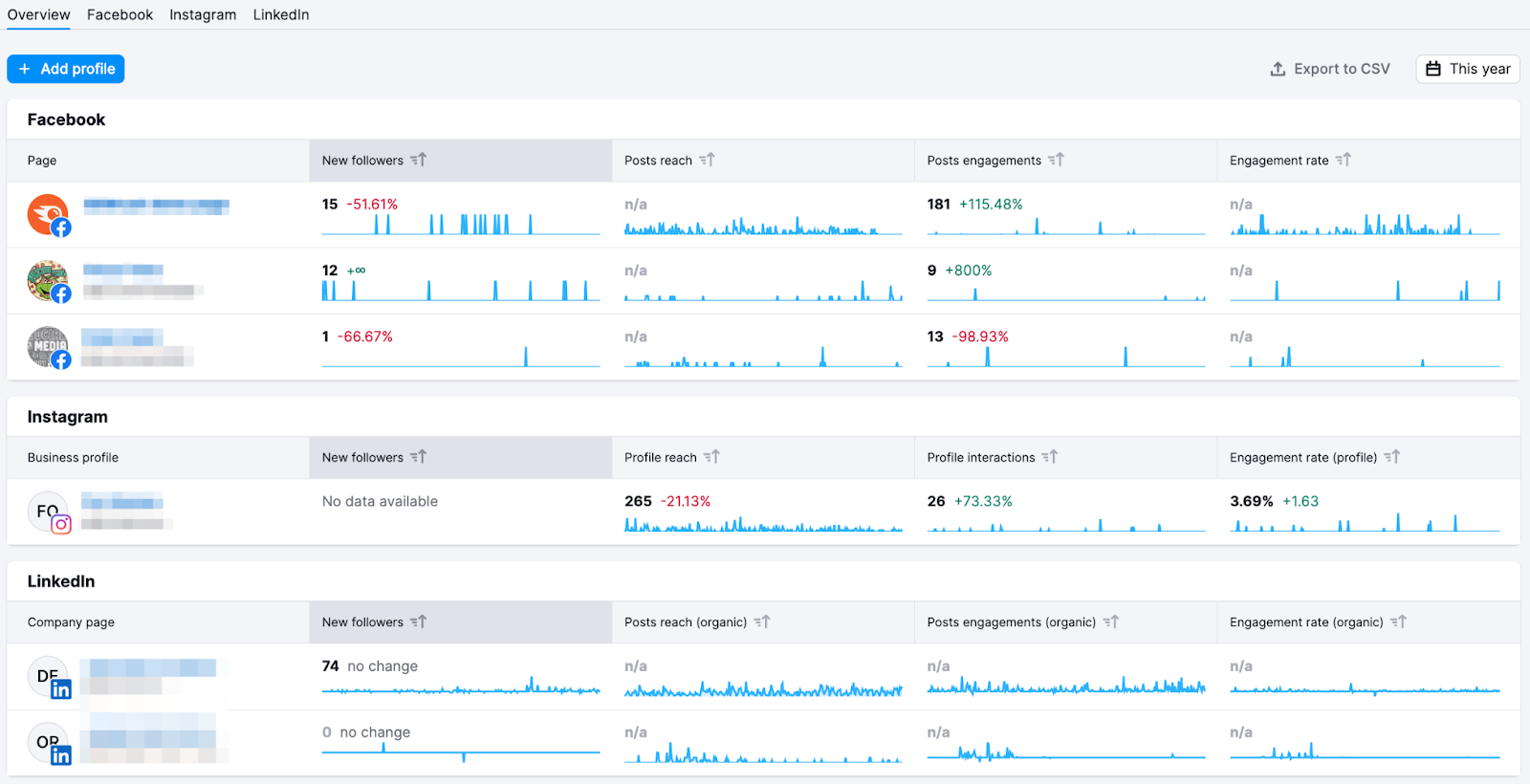
You can also analyze individual social media channel metrics to better understand your performance there.
You can also use Social Poster to schedule posts across different platforms, manage your approval process and more.
6. Run Influencer Marketing Campaigns
Collaborating with influencers is an excellent ecommerce growth strategy.
When you work with influencers, you tap into their preexisting follower base.

You also leverage the trust that influencer has built with their followers.
Over the past few years, the number of people turning to influencers for purchasing decisions has risen. About 54% of 18-29 year old social media users report that influencers impact their purchasing decisions. For people in the age range 30-49, the number stands at 42%.
Farfetch’s collaboration with Tim Dessaint is a killer example of ecommerce influencer collaboration.
Farfetch is an ecommerce brand that sells luxury fashion and beauty products.
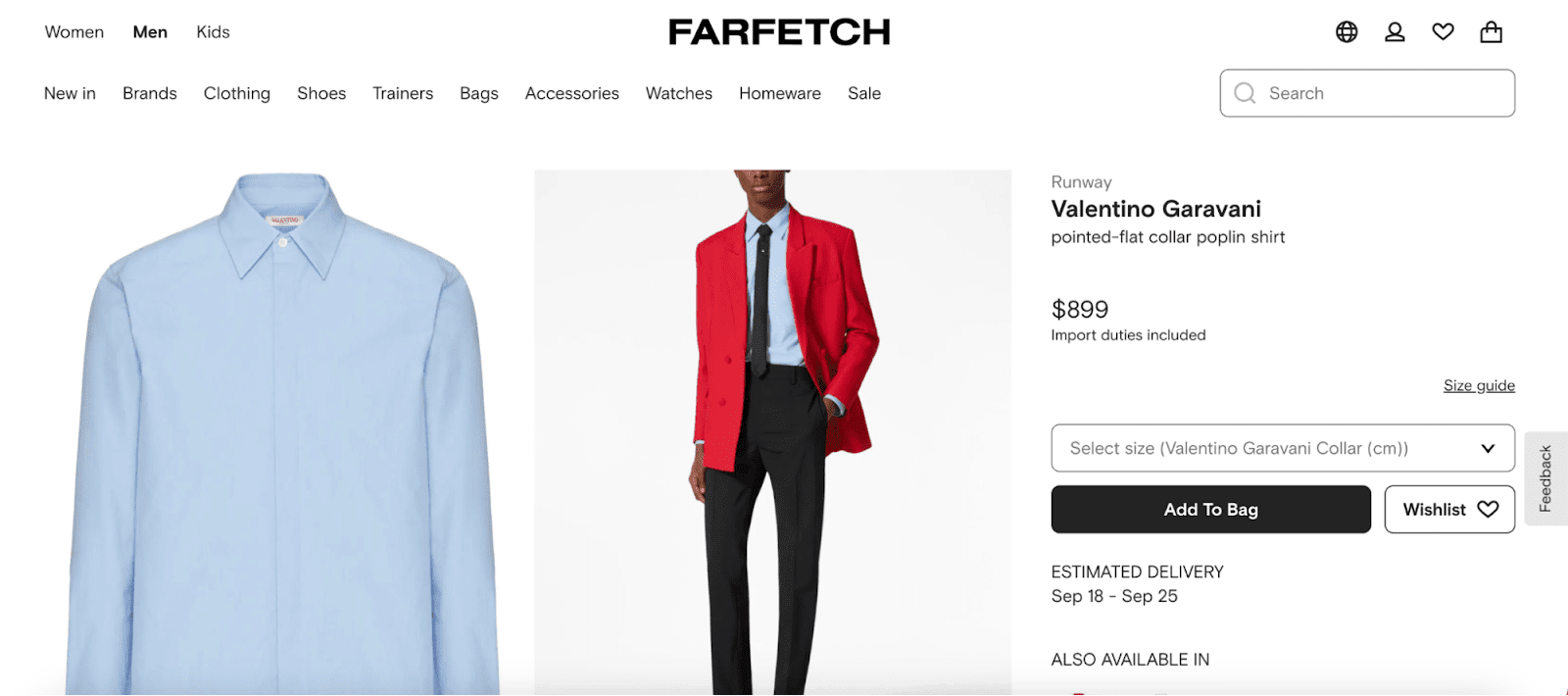
And Tim Dessiant is a widely popular men’s fashion and lifestyle content creator. He has more than 1 million subscribers on YouTube.

Farfetch sponsored one of Tim’s YouTube videos where he talks about 10 expensive clothing items. The majority of items listed are from Farfetch’s online store.
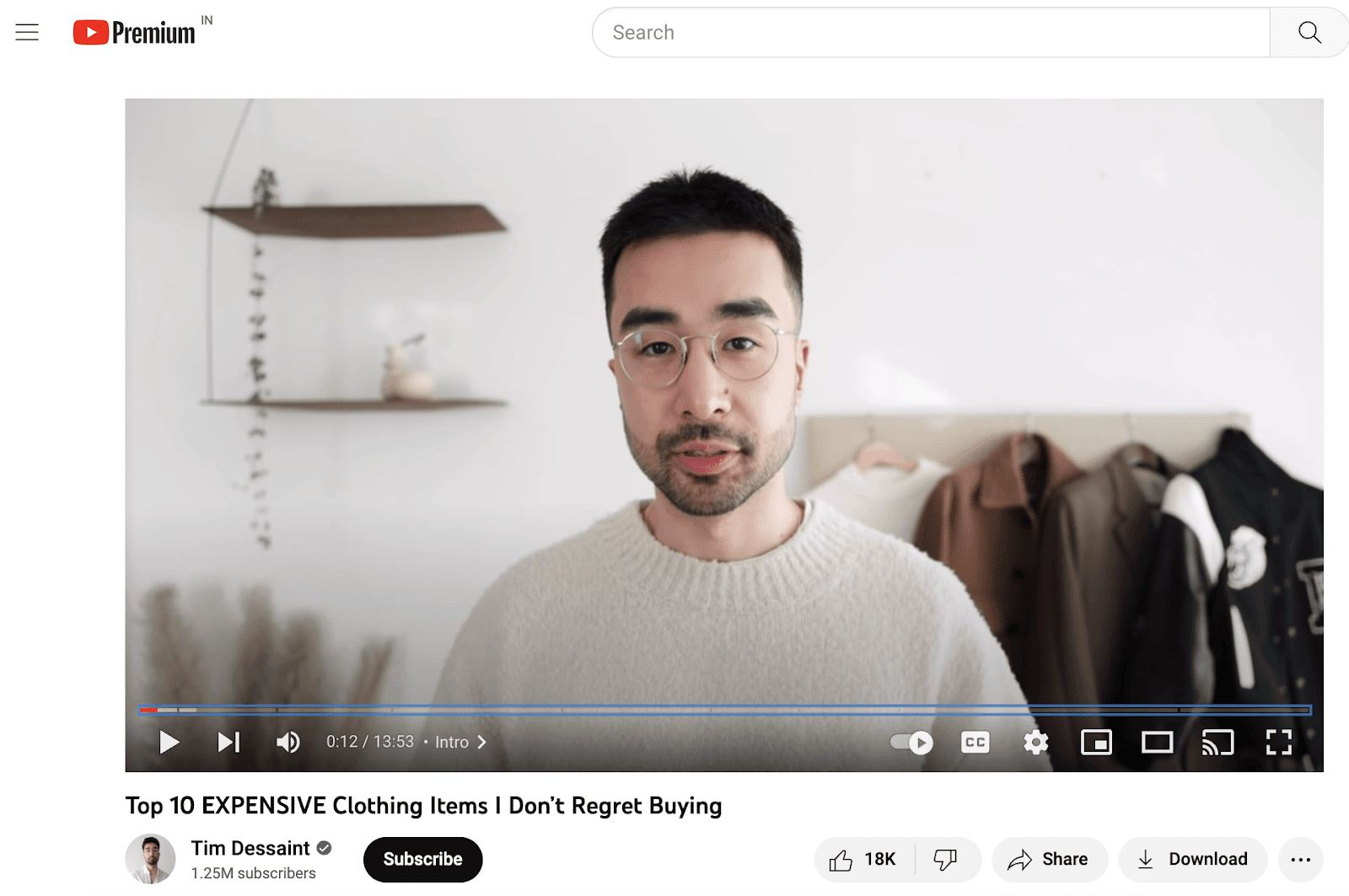
This collaboration let Farfetch tap into Tim’s 1M+ YouTube subscribers. It helped them increase their exposure and put their products in front of more potential customers.
Influencer marketing is a powerful ecommerce marketing strategy.
To run a successful influencer marketing campaign, here are a few important tips you should consider:
Collaborate with the Right Influencers
Work only with influencers whose followers/subscribers are within your target audience demographics.

And don’t just focus on the reach they command. Make sure their engagement rate is high.
Otherwise, you risk wasting your time, money, and efforts on failed campaigns.
Work with Influencers with Small(er) Audiences
So many companies want to work with influencers who have a large reach. But working with big influencers is very costly.
Mega influencers (those with over a million followers/subscribers) charge $10,000+ per Instagram post.
Even macro influencers (those with 500,000-1,000,000 followers/subscribers) charge anywhere between $5,000 and $10,000 per Instagram post.
You may have a limited influencer marketing budget if you’re just getting started. Don’t let that stop you.
You can still run a profitable influencer marketing by collaborating with nano-influencers (those with 1,000–10,000 followers/subscribers) and micro-influencers (those with 10,000–50,000 followers/subscribers).
Working with nano- and micro-influencers is an excellent way to run a budget-friendly influencer marketing campaign.

Even better, these influencers often have engagement rates that are higher than mega and macro influencers. Their audience is more likely to interact, comment, share, and take action on their posts.
And since they have a lower follower/subscriber base, they may not be working with multiple brands at once. They can allocate more time to your campaign.
Use an All-in-One Influencer Marketing Platform
Running a profitable influencer marketing campaign is tough. There are many moving parts involved:
- Finding the right influencers
- Vetting these influencers to make sure they’re a brand fit
- Reaching out to them
- Negotiating terms and compensation
- Creating a clear and impactful campaign brief
- Coordinating content creation and posting schedules
- Tracking your influencer marketing efforts
It gets even more complex if you’re working with several influencers at a time.
Using an all-in-one influencer marketing platform like Influencer Analytics makes it easier.
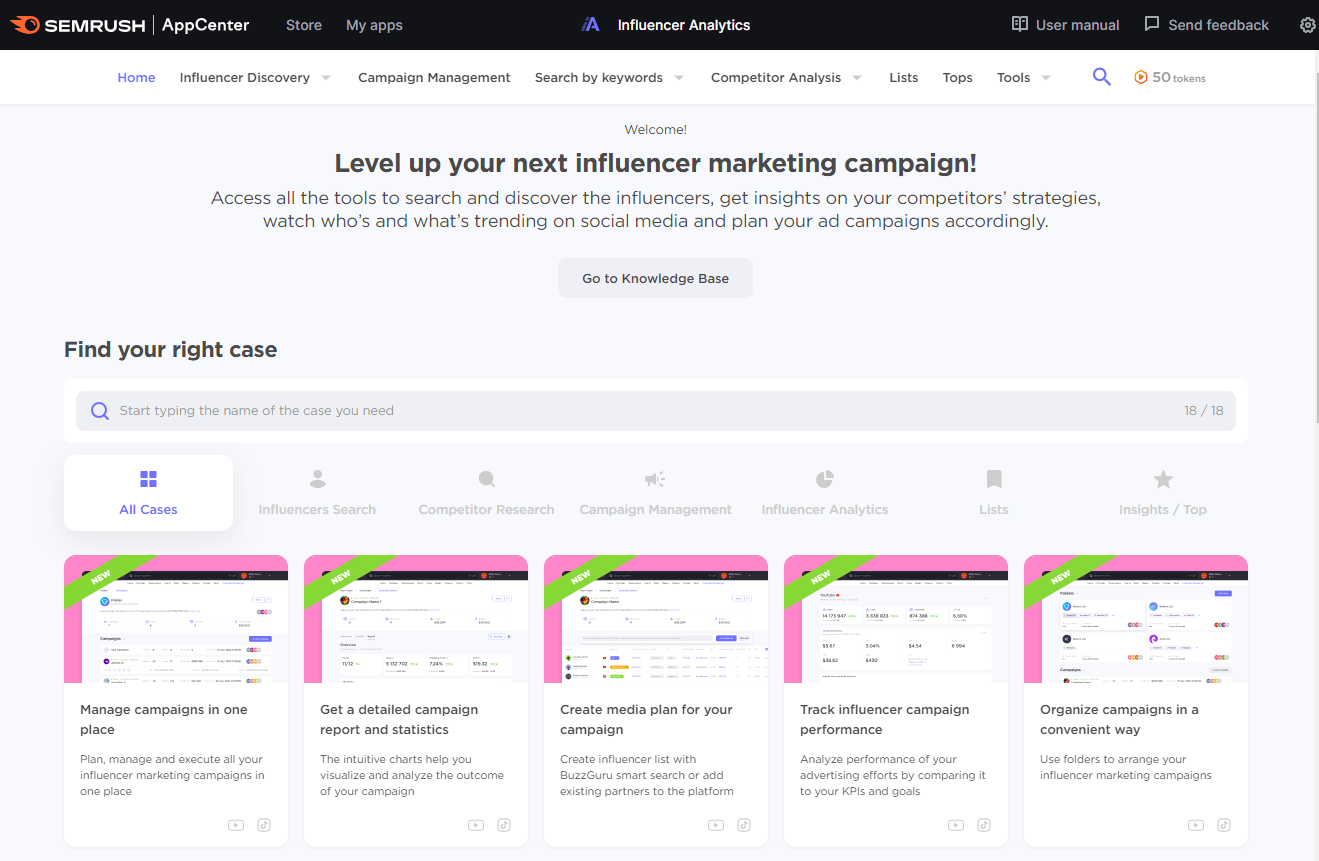
The platform:
- Offers several filters to help find the right influencers
- Forecasts your campaign costs
- Performs market and trend analysis
- Manages influencer marketing campaigns
And more.
7. Establish Your Presence on Ecommerce Marketplaces
Establishing your presence on ecommerce marketplaces is another strategic move that can expand your reach and increase your sales.
Ecommerce marketplaces like Amazon, Walmart, eBay, and Alibaba attract millions of shoppers each month.
By building your storefronts on these marketplaces, you can put your products in front of those marketplace shoppers and expand your customer base.
But that’s just one part of the equation.
Here are more benefits of using ecommerce marketplaces:
- They have massive customer bases
- Shoppers trust these platforms. They’re more likely to purchase because they’re familiar with the interfaces, have confidence in the buying process, and often feel safer with the payment and return policies in place.
- They offer several ecommerce marketing tools and functionalities to grow and protect your business
- Some marketplaces offer warehousing, packaging, and shipping solutions, making it easier for sellers to manage orders
An example: Weiman, a surface cleaning manufacturer, has established their presence across multiple ecommerce marketplaces.
Here’s a screenshot of their Amazon storefront:
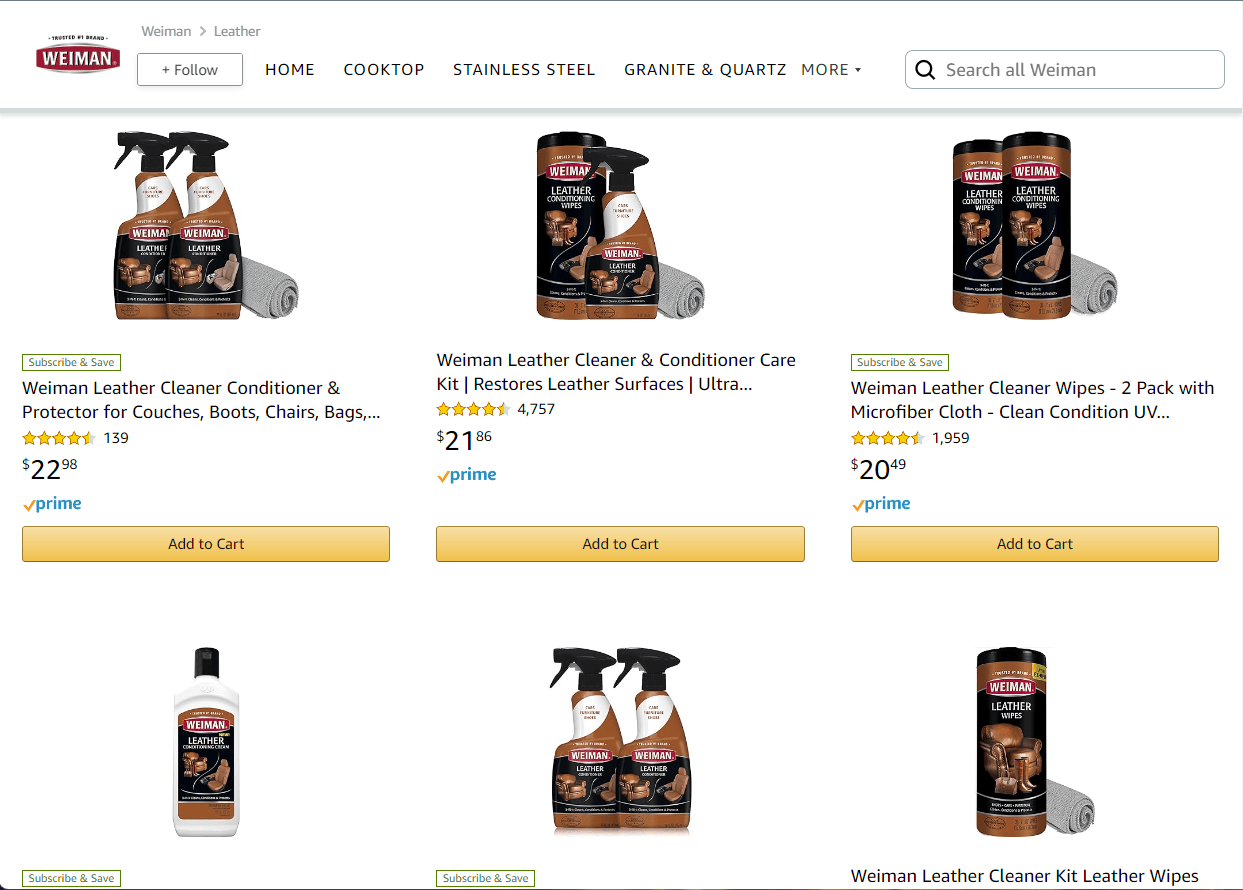
They can also be found on Walmart:
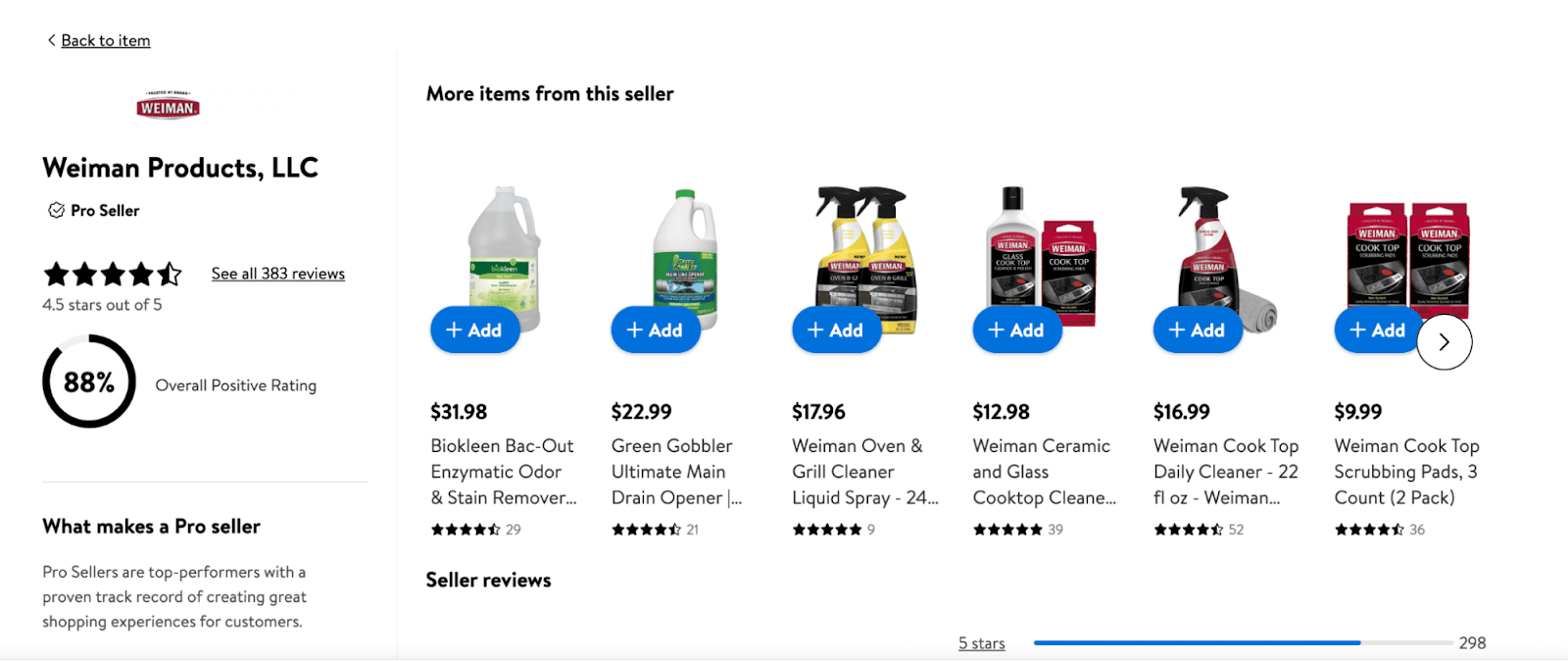
Just like Weiman, you can also reach more customers and grow your online store by establishing your presence across different ecommerce marketplaces.
8. Invest in Customer Service
For many online shoppers, customer service is a deciding factor when it comes to their choice of retailers.
Over 60% of customers make their purchasing decisions based on the quality of customer service, according to a study by Zendesk. And 73% of customers say they would switch to a company’s competitor after a few bad customer service experiences.
This highlights how important it is to deliver exceptional customer service today.
Consistently offering excellent customer service can help ecommerce stores retain their existing customers. And turn their customers into brand advocates who will recommend your business to others.
Here are a few tips for delivering exceptional customer service:
Offer Multi-Channel Support
People prefer different modes of communication.
Whether it’s live chat, email, or social media, make it easy for your customers to reach you on their preferred platforms.
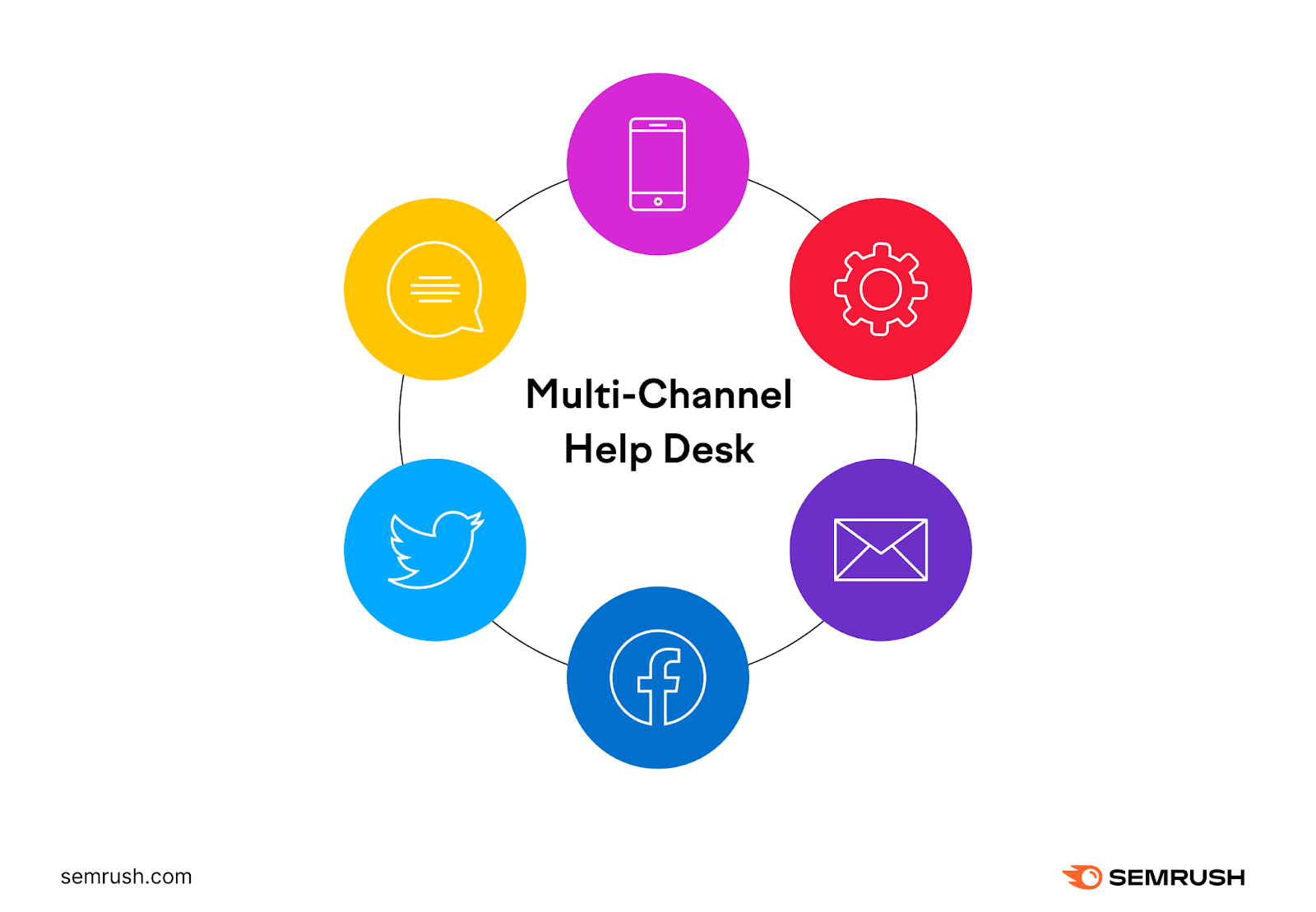
To help your support team keep track of customer interactions across multiple platforms, consider investing in an all-in-one customer service helpdesk like Help Scout or Gorgias. These tools centralize communication all in one place.
Implement an AI-Powered Chatbot
An AI-powered chatbot provides immediate assistance to customers. As it addresses their concerns and queries in real time.
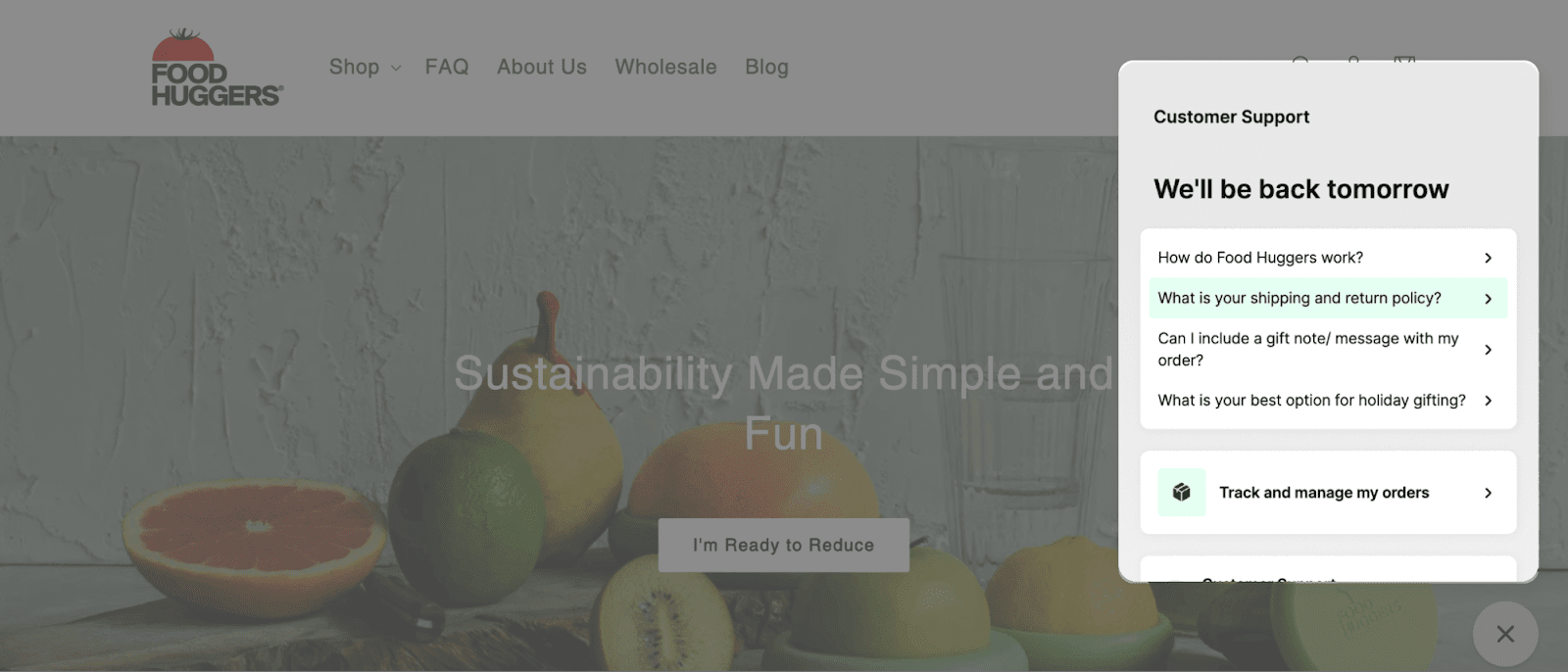
This not only enhances their shopping experience but can also reduce cart abandonment rates.
As customers can have their questions answered immediately.
Offer Multiple Self-Service Options
Self-service options are resources that allow customers to find information that lets them resolve issues on their own. Without contacting a customer service representative.
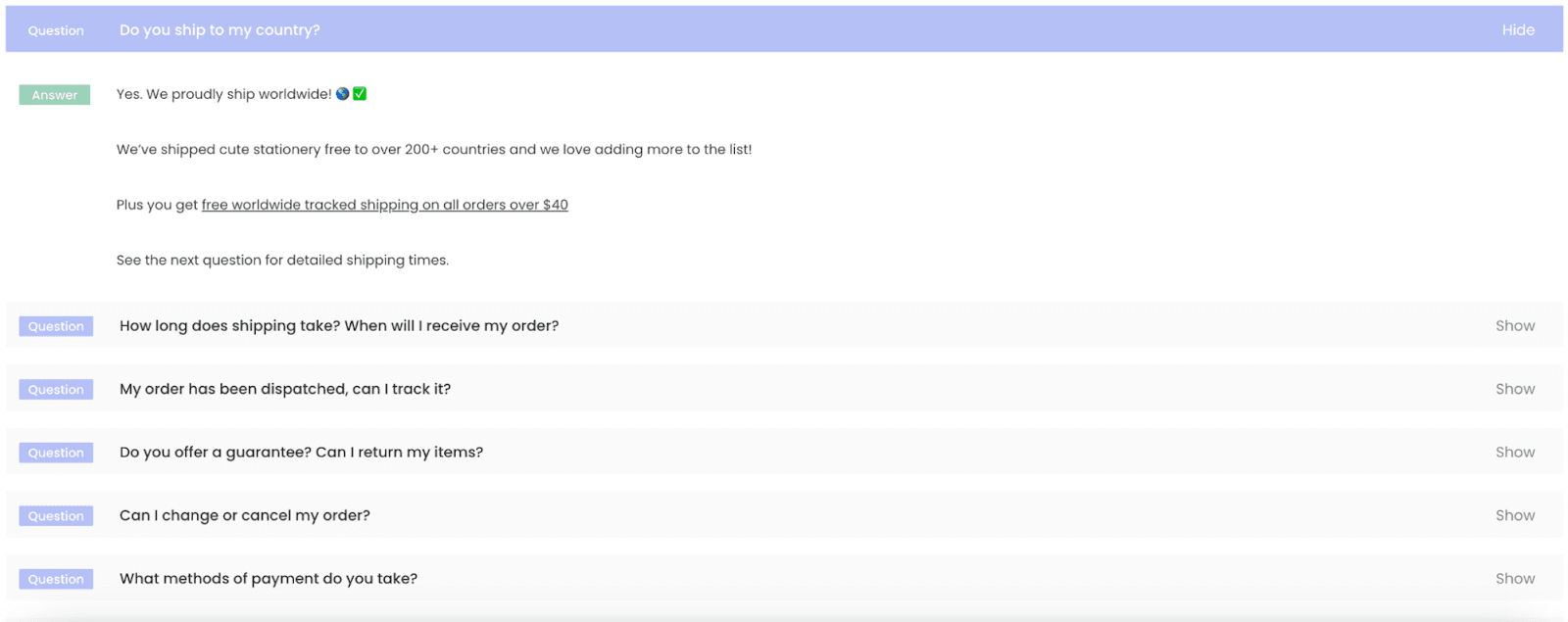
These include FAQs, downloadable resources, blog posts, video tutorials, and more.
Bringing It All Together: Your Ecommerce Growth Strategy
Growing an ecommerce business in today’s fiercely competitive market is tough.
Whether it’s a focus on delivering exceptional customer service, running a multi-channel influencer marketing campaign, building an enviable loyalty program, or getting to the top of the search results for every high-priority keyword on your list, the right tools in your ecommerce strategy framework are your key to success.
Finding the best ecommerce strategies for your business is the only way you can stand out and thrive. Explore SEO, social, and more for your ecommerce business with Semrush:
Source link : Semrush.com
